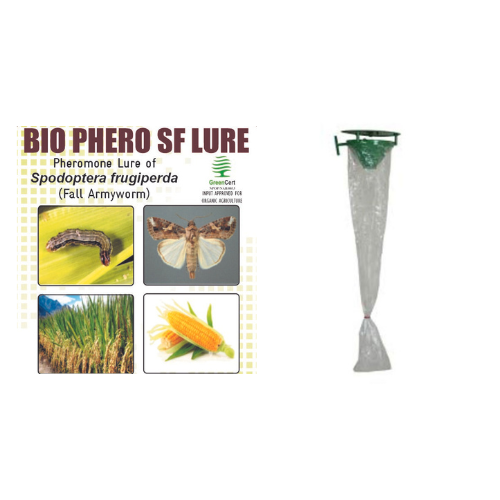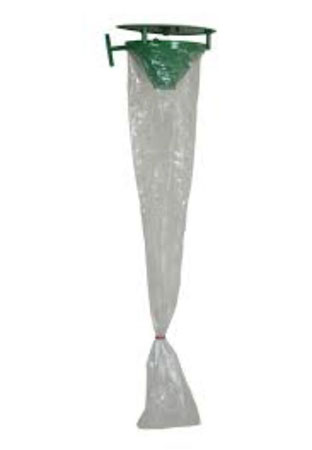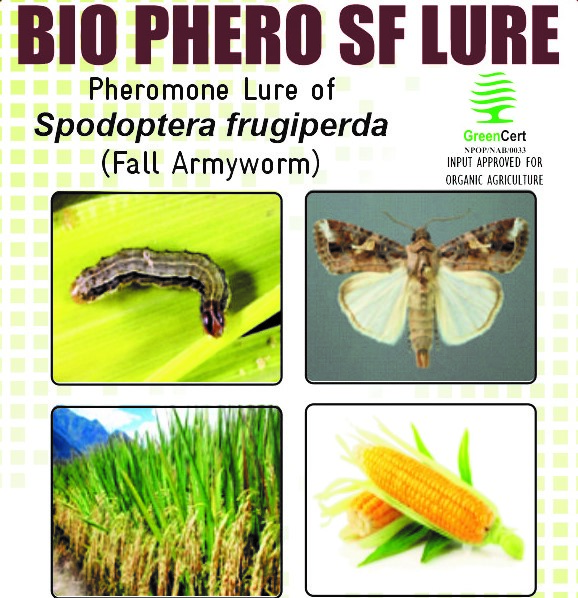




SONKUL AGRO INDUSTRIES PRIVATE LIMITED
Lure With Trap
Pheromone lure for Fall Armyworm (Spodoptera frugiperda). Control Fall Armyworm with BIO PHERO SF LURE.
Target Plants: Maize, Rice, Sugarcane, and other crops
Usage Instruction-
Cut open this pack and slide the lure piece outside.
Do not touch the lure with bare hands.
Fix this lure properly in a trap by sliding it into the hole provided in the funnel trap.
Replace the lure at the recommended duration. Wash hands thoroughly before and after handling the trap and lure.
Discard used lure by burning or burying underground.
Trap to be used: Funnel Trap
Number of traps per Acre: 7-8
Life of Lure: 60 Days
Contents:
Pheromone lure of Spodoptera frugiperda (Fall Armyworm)
The fall army worm, Spodoptera frugiperda, is a major invasive pest attacking maize, jowar, sugarcane, and many other crops. It has a voracious appetite and feeds on more than 80 plant species, including maize, rice, sorghum, and sugarcane. It has the ability to spread and reproduce quickly.
Identification-
Eggs are pale green or white at the beginning, get covered in scales, and turn clear brown to brown before hatching.
They hatch within 2 – 3 days. There are 6 larvae stages. Young larvae are pale-colored. They become brown to pale green, they are darker at the latest stages.
The larval stage lasts for 12 – 20 days depending on ambient temperature and other environmental conditions. Half-grown or fully-grown caterpillars are the easiest to identify.
The larvae are generally characterized by 3 yellow stripes on the back, followed by a black, then a yellow strip on the side. Look out for four dark spots forming a square on the second to last segment.
Each spot has a short bristle (hair). The head is dark it shows a typical upside-down Y-shaped pale marking on the front. The pupa is dark brown and hides in the soil, more rarely in the stalk. Pupa lives 12 – 14 days before an adult emerges.
The moth is 3 to 4 cm wide. Its front wings are dark brown while the rare wings are grey-white. It will live 2 to 3 weeks before dying.
Life Cycle and Nature of Damage:
100-200 eggs are generally laid on the underside of the leaves typically near the base of the plant, close to the junction of the leaf and the stem. These are covered in protective scales rubbed off from the moths' abdomen after laying. When populations are high then the eggs may be laid higher up the plants or on nearby vegetation.
After hatching the young caterpillars feed superficially, usually on the undersides of leaves. Feeding results in semi-transparent patches on the leaves called windows. Young caterpillars can spin silken threads which catch the wind and transport the caterpillars to a new plant. The leaf whorl is preferred in young plants, whereas the leaves around the cob silks are attractive in older plants. Feeding is more active during the night.
By stages 3-6, it will have reached the protective region of the whorl, where it does the most damage, resulting in ragged holes in the leaves. Feeding on young plants can kill the growing point resulting in no new leaves or cobs developing.
Often only 1 or 2 caterpillars are found in each whorl, as they become cannibalistic when larger and will eat each other to reduce competition for food. Large quantities of frass (caterpillar poo) are present. When this dries it resembles sawdust.
After approximately 14 days, the fully grown caterpillar will drop to the ground. The caterpillar will then burrow 2-8 cm into the soil before pupating.
The loose silk oval shape cocoon is 20-30 mm in length. If the soil is too hard then the caterpillar will cover itself in leaf debris before pupating. After approximately 8-9 days the adult moth emerges to restart the cycle.
Target Plants: Maize, Rice, Sugarcane, and other crops
Usage Instruction-
Cut open this pack and slide the lure piece outside.
Do not touch the lure with bare hands.
Fix this lure properly in a trap by sliding it into the hole provided in the funnel trap.
Replace the lure at the recommended duration. Wash hands thoroughly before and after handling the trap and lure.
Discard used lure by burning or burying underground.
Trap to be used: Funnel Trap
Number of traps per Acre: 7-8Life of Lure: 60 Days
Funnel Trap-
pheromones are sex attractants. The adult female insect which is ready for mating emits species-specific chemical odor to attract males.
These specific chemicals called Pheromones are synthesized and used for insect pest management in crops. The Funnel Trap consists of a funnel section and a polythene bag.
A central pheromone dispenser holder is located on top of the funnel under an umbrella-type cover.
The traps are used in combination with pheromone dispensers. Funnel traps are useful tools for monitoring moths. They give information on the population density of the pest and help the grower determine the optimal control strategy.
These traps are designed for multi-season use and are resistant to severe weather conditions. They are very easy to assemble and clean.